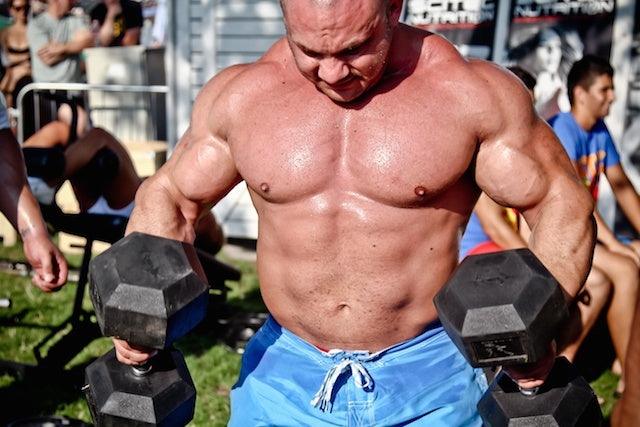

Androgen Receptors: Pack on More Muscle
Table of Contents
Androgen Receptors: Pack on the Muscle
By Robbie Durand
Testosterone and other androgen’s are thought to increase lean body mass and reduce fat body mass in men by activating the androgen receptor. You can have all the testosterone in the world floating in your system, but if you don’t have the androgen receptors to bind to…your screwed. Its like driving your brand new Bentley around your house, but not having a parking spot. Previous studies have shown that selective overexpression of androgen receptor in muscle cells of transgenic male rats both increases lean mass percentage and reduces fat mass. Whats interesting is that the study showed that increasing the number of androgen receptors not only increases muscle mass but reduced body fat. These results indicate that androgen signaling in muscle not only increases muscle mass but also reduces fat body mass, likely via increases in metabolism. Also, studies that have blocked or resulted in a genetic suppression of the androgen receptor results in muscular atrophy in males.
The previous dogma regarding testosterone and androgen receptors is that testosterone down-regulates the androgen receptor, but now we know its just the opposite. Testosterone administration has been shown to up-regulate the androgen receptor. In addition to testosterone administration, there are two other things that have been shown to increase androgen receptor concentration.
There are 2 ways to increase androgen receptors in muscle:
- resistance exercise and
- L-Carnitine-L-Tartrate
Resistance Exercise Increases in Androgen Receptors

Increased serum testosterone occurs in response to resistance exercise and is associated with increased muscle mass. Researchers had men perform three lower-body resistance exercise bouts, each separated by 48 h. At each exercise bout, subjects performed three sets of 8-10 repetitions at 75-80% one-repetition maximum using the squat, leg press, and leg extension exercises, respectively. Muscle biopsies were obtained immediately before the first exercise bout and 48 h after each of the three bouts, whereas blood samples were obtained immediately before, immediately after, and 30 min after each bout. Serum testosterone were increased after each exercise bout; however, androgen receptors were significantly increased after the second and third exercise bouts, respectively, and were significantly correlated to testosterone levels. Three sequential bouts of heavy resistance exercise increases serum testosterone and are effective at up-regulating androgen receptors. Another study stimulated the legs muscles of a rat with electric muscle stimulator, its androgen receptor density increased. The researches left the another foot unstimulated and found out that there was no such activity seen in the ‘control’ foot. This led the researchers to a conclusion that muscle stimuli (exercise) increases the amount of androgen receptors in the skeletal muscle. The testosterone response to resistance exercise is highly variable.
In another study in which men performed heavy concentric and eccentric contractions. The researchers found a substantial increase in androgen receptor mRNA concentration after both CON and ECC loading. This is similar to rat studies showing that androgen receptor content was increased in type II muscle after resistance training in rats. Also in rats, gastrocnemius hypertrophy by electrical stimulation has been associated with an increased number of muscle androgen receptors.
Foods that are Good for Androgen Receptors

Zinc is an essential dietary mineral. You need zinc for your immune system to function properly and for cell division. Zinc helps enzymes break down food and other nutrients. It also plays an important role in enzymes that build proteins. It can be found in certain foods, but it’s also available in supplements and even certain cold medications. Having a zinc deficiency can lead to low testosterone. Exactly why a lack of zinc impacts testosterone levels is not fully understood. The mineral may affect the cells in the testes that produce testosterone (as opposed to testosterone-producing glands).
Research into the effectiveness of zinc for hypogonadism is limited. But guided and appropriate supplementation may help raise your testosterone levels. One study researched the effects of a magnesium and zinc supplement. It found that men who received 30 milligrams of zinc per day showed increased levels of free testosterone in their bodies. Pumpkin seeds are high in zinc. Zinc has been shown to increase testosterone receptors to make the most out of increased testosterone levels. Also, eating grass fed, organic red meat two to three times per week will also provide sufficient zinc. Beef is also a good source of complete protein. Diets such as the Primal Blueprint or other various takes on the paleo diet are the best for hormone and hormone receptor expression.
- Pumpkin Seeds
- oysters
- beef
- crab
- fortified cereals and breads
- pork
- beans
- chicken
- yogurt
- nuts
- oatmeal
- dietary supplements

Supplements that Increase Androgen Receptor Concentration
You probably recognize the amino acid L-Carnitine, which is naturally-occurring in your body and involved in hundreds of processes. It turns out that the best forms of L-Carnitine are its subcompounds, each of which targets specific jobs after your body converts it from regular L-Carnitine.
Types of L-Carnitine
- L-Carnitine L-Tartrate (LCLT): Best for muscle recovery and improved function of your androgen receptors. Another study showed that LCLT enhanced the oxygenation of post-workout muscle tissue, which improved it during sprint work.
- Acetyl L-Carnitine (ALCAR):has been shown to enhance cognitive function.
- Glycine Propionyl L-Carnitine (GPLC): Has been shown to improve blood flow and used for a nitric oxide boost
- Propionyl L-Carnitine (PLCAR): Best for metabolism and fat burning
Carnitine is a necessary component of fat oxidation in cells. Carnitine acts in a transport of long-chain fatty acids to the mitochondrial matrix for oxidation thus plays and important role in energy metabolism. However, a new more promising form of carnitine emerged: L-Carnitine-L-Tartrate (LCLT). A tartrate is a salt or ester of the organic compound tartaric acid and it is used in some supplements to improve absorption of another substance.
In 2006 the researchers published the results of an experiment they carried out with 10 experienced male strength trainers. The men trained their most important muscle groups by doing squats, bench press, bent-over rows and shoulder press. They did 4 sets of 10 reps for each exercise. The subjects trained in the mornings before breakfast. On one occasion they drank water after their training session, on the other they consumed a meal substitute, which provided 8 kcal per kg bodyweight. This contained 1.1 g carbohydrates, 0.3 g whole protein and 0.25 g fat
When the researchers examined muscle cells from the men’s legs, they noticed that the carnitine supplementation had raised the manufacture of androgen receptors. Eating a meal after the training session also increased the number of androgen receptors, but the effect was stronger when the men took carnitine as well. But the indisputable research on L-Carnitine doesn’t stop there. In a 21-day human, clinical, placebo-controlled study that was later published in a leading American physiological journal, L-Carnitine supplementation supported muscle tissue regeneration.
Among other measuring techniques, researchers used magnetic resonance imaging (MRI), to test the effects of a 2 gram per day dose of L-Carnitine, enough to maximize plasma carnitine concentration, on a group of healthy, recreationally weight-trained men. L-Carnitine reduced exercise-induced catabolism (muscle breakdown), reduced free-radical generation, and minimized muscle tissue disruption compared to the placebo. In other words, L-Carnitine optimized a favorable anabolic recovery environment primed for dramatic muscle gains.

Another study to note is when individuals used a minimum of 2g of LCLT a day for a span of one month. When subjects had blood drawn they noted that the amount of muscle damage from exercise was reduced. There was also an increase in plasma malondeldehyde showing improved recovery and also enhanced oxygen consumption to the cells in the body. Not only that the individuals when training noted less rest times, increased pump, and also better blood flow. LCLT may not be a very heavily studied ingredient but the facts are clear. An increase in fat loss over prolonged periods of time, increased pump, boosted performance, and prolonged endurance in exercise and training. With multiple studies to back its name this is something to consider into your supplement stack.
Carnitine Turns on Anabolic Genes
Just when you think it can’t get any better, it does!! Carnitine has been also found to turn on anabolic signaling genes as well. When carnitine was examined on how it impacted genes in muscle, the potent anabolic signaling pathway IGF and insulin signalling were significantly up-regulated in the carnitine group and some of the catabolic pathway genes were also turned down. Conclusion: Carnitine may have beneficial effects on skeletal muscle mass through stimulating the anabolic IGF-1 pathway and suppressing atrophy-related genes.
Keller J, Ringseis R, Priebe S, Guthke R, Kluge H, Eder K. Dietary L-carnitine alters gene expression in skeletal muscle of piglets. Mol Nutr Food Res. 2011 Mar;55(3):419-29.
Lee WJ, Thompson RW, McClung JM, Carson JA. Regulation of androgen receptorexpression at the onset of functional overload in rat plantaris muscle. Am J Physiol Regul Integr Comp Physiol. 2003 Nov;285(5):R1076-85.
Willoughby DS, Taylor L. Effects of sequential bouts of resistance exercise on androgen receptor expression. Med Sci Sports Exerc. 2004 Sep;36(9):1499-506.
Spiering, B. A., W. J. Kraemer, et al. (2009). “Elevated endogenous testosterone concentrations potentiate muscle androgen receptor responses to resistance exercise.” J Steroid Biochem Mol Biol 114(3-5): 195-199.
Volek, Jeff S. Et al (2002). L-Carnitine L-Tartrate Supplementation Favorable Affects Markers of Recovery from Exercise Stress. American Journal of Endocrinology and Metabolism 282: E474-E482.
Prasad AS, Mantzoros CS, Beck FW, Hess JW, Brewer GJ. Zinc status and serum testosterone levels of healthy adults. Nutrition. 1996 May;12(5):344-8.
Inoue K, Yamasaki S, Fushiki T, Kano T, Moritani T, Itoh K, Sugimoto E. (1993) Rapid increase in the number of androgen receptors following electrical stimulation of the rat muscle. Eur J Appl Physiol Occup Physiol 66:134–140.
Bamman MM, Shipp JR, Jiang J, Gower BA, Hunter GR, Goodman A, McLafferty CL Jr, Urban RJ. Mechanical load increases muscle IGF-I and androgen receptor mRNA concentrations in humans. Am J Physiol Endocrinol Metab. 2001 Mar;280(3):E383-90.

















